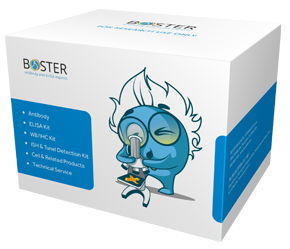Product Info Summary
| SKU: | A30545 |
|---|---|
| Size: | 100ul |
| Reactive Species: | Human, Mouse |
| Host: | Rabbit |
| Application: | ELISA, WB |
Customers Who Bought This Also Bought
Product info
Product Name
Anti-KPBB PHKB Antibody
View all Phosphorylase B Antibodies
SKU/Catalog Number
A30545
Size
100ul
Form
Liquid
Description
Boster Bio Anti-KPBB PHKB Antibody (Catalog# A30545). Tested in WB, ELISA applications. This antibody reacts with Human, Mouse.
Storage & Handling
Store at -20°C for one year. For short-term storage and frequent use, store at 4°C for up to one month. Avoid repeated freeze-thaw cycles.
Cite This Product
Anti-KPBB PHKB Antibody (Boster Biological Technology, Pleasanton CA, USA, Catalog # A30545)
Host
Rabbit
Contents
PBS containing 50% glycerol, 0.5% BSA and 0.02% sodium azide.
Clonality
Polyclonal
Isotype
Rabbit IgG
Immunogen
A peptide derived from human KPBB. Immunogen sequence location: 661-710
*Blocking peptide can be purchased. Costs vary based on immunogen length. Contact us for pricing.
Reactive Species
A30545 is reactive to PHKB in Human, Mouse
Reconstitution
Observed Molecular Weight
72 kDa
Calculated molecular weight
124884 MW
Antibody Validation
Boster validates all antibodies on WB, IHC, ICC, Immunofluorescence, and ELISA with known positive control and negative samples to ensure specificity and high affinity, including thorough antibody incubations.
Application & Images
Applications
A30545 is guaranteed for ELISA, WB Boster Guarantee
Assay Dilutions Recommendation
The recommendations below provide a starting point for assay optimization. The actual working concentration varies and should be decided by the user.
Western Blot, 1:500 - 1:2000
ELISA, 1:40000
Not yet tested in other applications.
Validation Images & Assay Conditions

Click image to see more details
Western blot analysis of lysates from K562 cells, using KPBB Antibody. The lane on the right is blocked with the synthesized peptide.
Protein Target Info & Infographic
Gene/Protein Information For PHKB (Source: Uniprot.org, NCBI)
Gene Name
PHKB
Full Name
Phosphorylase b kinase regulatory subunit beta
Weight
124884 MW
Superfamily
phosphorylase b kinase regulatory chain family
Alternative Names
PHKB;Phosphorylase b kinase regulatory subunit beta;Phosphorylase kinase subunit beta PHKB phosphorylase kinase regulatory subunit beta phosphorylase b kinase regulatory subunit beta|phosphorylase kinase beta-subunit|phosphorylase kinase subunit beta|phosphorylase kinase, beta
*If product is indicated to react with multiple species, protein info is based on the gene entry specified above in "Species".For more info on PHKB, check out the PHKB Infographic

We have 30,000+ of these available, one for each gene! Check them out.
In this infographic, you will see the following information for PHKB: database IDs, superfamily, protein function, synonyms, molecular weight, chromosomal locations, tissues of expression, subcellular locations, post-translational modifications, and related diseases, research areas & pathways. If you want to see more information included, or would like to contribute to it and be acknowledged, please contact [email protected].
Specific Publications For Anti-KPBB PHKB Antibody (A30545)
Hello CJ!
No publications found for A30545
*Do you have publications using this product? Share with us and receive a reward. Ask us for more details.
Recommended Resources
Here are featured tools and databases that you might find useful.
- Boster's Pathways Library
- Protein Databases
- Bioscience Research Protocol Resources
- Data Processing & Analysis Software
- Photo Editing Software
- Scientific Literature Resources
- Research Paper Management Tools
- Molecular Biology Software
- Primer Design Tools
- Bioinformatics Tools
- Phylogenetic Tree Analysis
Customer Reviews
Have you used Anti-KPBB PHKB Antibody?
Submit a review and receive an Amazon gift card.
- $30 for a review with an image
0 Reviews For Anti-KPBB PHKB Antibody
Customer Q&As
Have a question?
Find answers in Q&As, reviews.
Can't find your answer?
Submit your question
4 Customer Q&As for Anti-KPBB PHKB Antibody
Question
I see that the anti-KPBB antibody A30545 works with WB, what is the protocol used to produce the result images on the product page?
Verified Customer
Verified customer
Asked: 2020-02-12
Answer
You can find protocols for WB on the "support/technical resources" section of our navigation menu. If you have any further questions, please send an email to [email protected]
Boster Scientific Support
Answered: 2020-02-12
Question
We are currently using anti-KPBB antibody A30545 for human tissue, and we are happy with the WB results. The species of reactivity given in the datasheet says human, mouse. Is it possible that the antibody can work on primate tissues as well?
Verified Customer
Verified customer
Asked: 2019-08-20
Answer
The anti-KPBB antibody (A30545) has not been validated for cross reactivity specifically with primate tissues, though there is a good chance of cross reactivity. We have an innovator award program that if you test this antibody and show it works in primate you can get your next antibody for free. Please contact me if I can help you with anything.
Boster Scientific Support
Answered: 2019-08-20
Question
Is this A30545 anti-KPBB antibody reactive to the isotypes of PHKB?
Verified Customer
Verified customer
Asked: 2018-02-16
Answer
The immunogen of A30545 anti-KPBB antibody is A peptide derived from human KPBB. Immunogen sequence location: 661-710. Could you tell me which isotype you are interested in so I can help see if the immunogen is part of this isotype?
Boster Scientific Support
Answered: 2018-02-16
Question
Does A30545 anti-KPBB antibody work on parafin embedded sections? If so, which fixation method do you recommend we use (PFA, paraformaldehyde, other)?
Verified Customer
Verified customer
Asked: 2017-07-06
Answer
As indicated on the product datasheet, A30545 anti-KPBB antibody as been validated on WB. It is best to use PFA for fixation because it has better tissue penetration ability. PFA needs to be prepared fresh before use. Long term stored PFA turns into formalin, as the PFA molecules congregate and become formalin.
Boster Scientific Support
Answered: 2017-07-06




